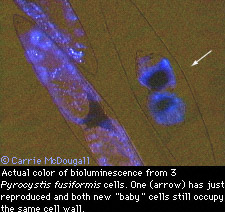| Dinoflagellates are relatively easy to maintain at home, requiring as little care as a houseplant, except that these "plants" produce bright blue light when shaken at night. For more technical culturing information, we have another page about Growing Dinos in the Lab Also see our page documenting a red tide of dinoflagellates.
Where to get bioluminescent dinoflagellates [Disclaimer: we have no ties to these companies and list them here as a service, not an endorsement.]
A very bright and very tolerant species is available via mail through this source: (Note: this species is non-toxic).
Another company is selling a variety of bioluminescent dinoflagellates. You can contact them via their web page.
(Not a related organism, but for class projects, you might also consider using luminous bacteria. Carolina Biological sells kits that provide an easy and inexpensive way to bring bioluminescence home, and there are many experiments you can do based on the unique properties of luminescent bacteria.)
Light & Temperature Requirements You will need to provide them with an appropriate amount of light on a regular basis because the only way they can grow is by producing their own food using a process called photosynthesis, just like plants do. So, make sure you grow them in a container that is clear so they can get light. They can grow in sunlight or artificial light as long as it's fairly bright but not too hot. As far as temperature, they need to be kept in an area that doesn't get too hot or too cold, so sometimes a window is not ideal. Also, don't keep them in your pocket or hold them too long because your body temperature will heat them up too much and they will die. Shipping is obviously a problem for these temperature reasons, sometimes the dinos don't survive shipping.
Light Cycles These dinoflagellates have a circadian rhythm
which controls their bioluminescence and photosynthesis on a 24-hour basis, i.e. they only photosynthesize when they “think” it's day
and they only produce bioluminescence or flash when they “think” it's night. So, you need to grow them on a strict light schedule, otherwise their natural rhythms can't synchronize with the light cycle and they won't know when to flash and when not to flash. Experimenting with the bioluminescence There are many different simple experiments you can do with your bioluminescent dinos. In a similar fashion to the way we perceive being touched, this is the type of stimulation that causes a dinoflagellate to produce a flash of light. Dinos are highly sensitive to anything that pushes on their cell wall,
even the seawater they live in can cause them to flash if it becomes very rough and stirred up. That is what is happening whenever you shake the container that your dinos live in, the water is becoming very turbulent and pushing on their cell walls causing them to flash.
Changing their light cycles is an interesting study, but remember that it takes the dinos about a week to get used to the new light
cycle (just like humans who travel to places that are in extremely different time zones, it takes a few days to get used to that time zone, because your circadian rhythms are confused). If you have a microscope to view the cells with, here are some observations you can make:
Currently, scientists are using the bioluminescence a dinoflagellate produces as an assay for detrimental effects caused by pollution
in various marine environments. The bioluminescence that a dinoflagellate can produce reflects how healthy it is. How to measure the light... Learn More About... (The last eight links will open the external site in a new window.)
[Download printable PDF version of this page] |
E-mail  |

